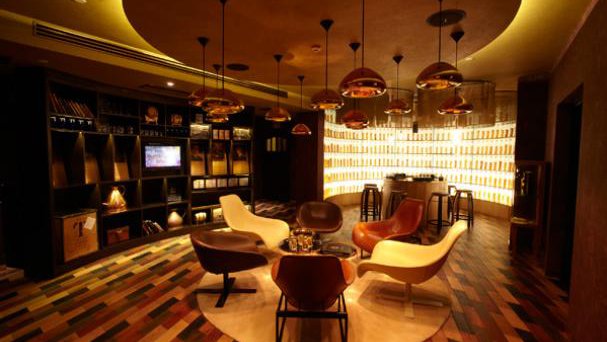
Karen Weiner Escalera, president & chief strategist at KWE Partners, details four ways in which luxury brand marketers can reinvent their marketing strategies for 2013
Karen Weiner Escalera, president & chief strategist at KWE Partners, details four ways in which luxury brand marketers can reinvent their marketing strategies for 2013
Luxury marketers and retailers have proven their resilience in a tough economy by sticking to their USPs: impeccable craftsmanship, artisanal, bespoke, exclusivity and razor-sharp service. Traditionally, consumers relied on functional values when making a luxury purchase decision. However, in contemporary times, there has been a shift to an emphasis on emotional and social values.
2013 will be the year where luxury brands must raise the bar by reinventing and reinvigorating their marketing strategies and look for new ways to brand and create new profit centres. In this issue, we’ll look at ways luxury brands are providing new solutions, whether it’s creating new lifestyle offshoots, experiences and environments, or developing new product lines and distribution channels.
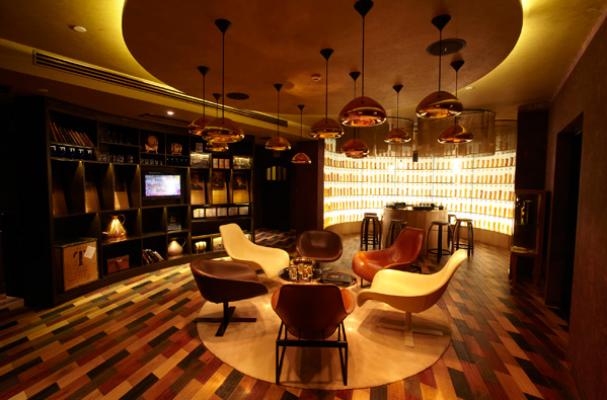
The Johnnie Walker House in Shanghai
Themed Experiences
Retail environments are becoming “themed brand stores” that serve as temples of socialisation; places where people don’t just pass through, but immerse in a world where they’ll stay, explore, have fun, meet others with the same passion, even learn – and do it with style. The average size of a flagship store has risen four to five times in the past five years to accommodate such in-store experiences.
The Johnnie Walker House in Shanghai offers fans a taste of whisky culture in an unprecedented way with interactive sensory journeys, inspirational forums, and decadent luxury dinners.
Mercedes Benz World in London includes a car exhibition, dining and driving experiences with the latest models; and various gentlemen’s club retail interiors have been trail blazed by luxury men’s brands such as Dunhill, Louis Vuitton and Austin Reed.
While the priority is branding and selling a core product (cars, scotch, fashions, etc.) auxiliary facilities and services are becoming added sources of revenue, ensuring that even if clients don’t buy the core product (the car, the outfit) they’ll walk out having bought a branded something.
With themed and pop up hotels, creativity can often trump costly frills and appointments. It’s all about guests coming for a particular experience and the anticipation of mingling among others with shared interests. For example, Snoozebox offers luxury short-term accommodations at seasonal hot spots providing guests with a holiday experience that connects to a place or event.
“ Mercedes Benz World in London includes a car exhibition, dining and driving experiences with the latest models ”
Its CarFest Pop Up Hotel encouraged guests to show off their classic cars along a boulevard that leads to a restaurant serving organic meat from a nearby farm. With drinks in hand, guests could mingle and talk cars just yards from the festival entrance. Snoozebox wants people to be able to smell the racing fuel and hear the cars in the distance.
Themed hotels also bring enthusiasts together. Hotel Tomo located in San Francisco’s Japantown, is uniquely themed around Japanese pop culture. For the Aria Hotel in Prague, a city known for its rich musical history, the theme of this five star luxury resort is that musical virtuosos and their fans can immerse themselves in music. From the Italian mosaic formed from a Gregorian chant to the surround-sound features in each room, every detail here is inspired by music.
It’s always fashion week at nHow, Berlin, which boasts “a passion for fashion” by embracing several fashion designers at once. Reception staff don headwear by Fiona Bennett designed exclusively for nHow. The bar staff wear exclusive designs by Berliner Esther Perbandt. And if you’re interested in what her ultramodern designs “taste” like, just order a Perbandt cocktail dedicated to the designer.
Or you can pretend you’re visiting Russia while staying at Moscow Hotel Dubai, UAE. Hotel aspects include influences from Russian theatre design, a recreation of the Bolshoi Dome, a Tolstoy Library, a Russian restaurant and a coffee shop selling strong coffees from Russia.
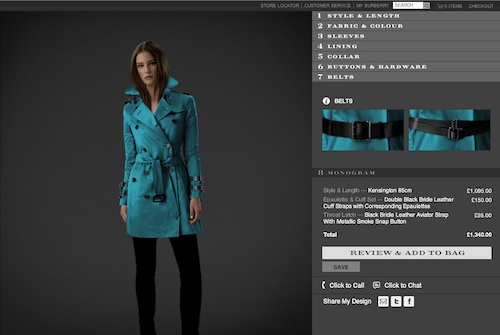
Burberry’s Bespoke customisation program
Accessible Customisation
Traditionally, “real” luxury delivered individualised products based on a buyer’s personal preferences, tastes and budget. It was a process that often involved a series of face-to-face interactions between individual clients and the skilled artisans who would craft the goods.
Today’s “revamping” of luxury is bringing the personalisation to the digital era. It’s spawned a new product level – mass customisation, which falls between the realms of truly bespoke and mass market. It is a powerful way for luxury brands to form deeper connections and create an engaging experience with a larger group of affluent consumers while maintaining brand integrity.
In recent seasons, luxury fashion brands have launched customisation platforms like Louis Vuitton’s Mon Monogram, which lets consumers add personal initials and colours to the brand’s bags, and Prada Customise, which lets buyers add personal lettering to bags and configure their own shoes and sunglasses.
But while these brands offer only light aesthetic customisation, British luxury brand Burberry has gone one step further, allowing true functional customisation called Burberry Bespoke. It gives consumers the ability to order their own customised version of their iconic trench coats, selecting styles, fabrics, colours, buttons, studs and other parameters. “There are more than 12 million options,” says Burberry.
Hotels, and to a lesser extent cruise lines, have toyed with this in recent years, offering customisation opportunities such as guest room scent, lighting and music but there’s long way to go in offering a new model.
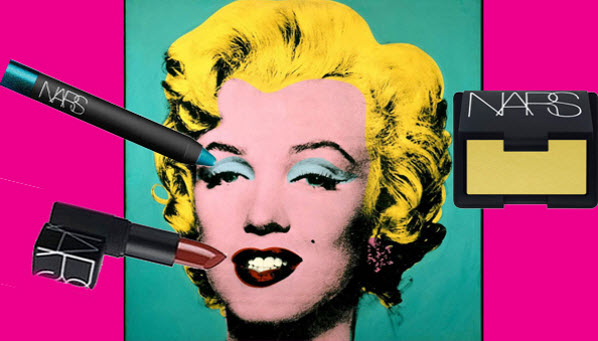
NARS Andy Warhol Collection
Tapping Into Art
We’ve written before that art is an important part of the affluent lifestyle and it’s making its way at a fast clip into all aspects of everyday life. In fashion for spring 2013, influences of dada and surrealism are easy to spot in Vivienne Westwood and Philip Treacy’s catwalk creations, Miuccia Prada reimagined Andy Warhol’s poppy flowers; Karl Lagerfeld inflected the sharp, angular lines of Cubism on to his Fendi collection.
Roberto Cavalli used Art Nouveau swirly motifs throughout his designs. More specifically, Etro’s latest collection was inspired by Hiroshige’s Ukiyo-e woodcut from 1833, and Proenza Schuler by Norwegian artist Bjarne Melgaard.
In beauty, NARS new Andy Warhol Collection includes a range of cosmetics packaged in film canisters. Taking its tribute to the pop art icon a step further online, the company has also launched its NARS Profile Makeover app in which users can “Warholize” Facebook photos, and other images for a visual makeover that combine Warhol’s artistic touch and NARS’ branding.
In real estate, Miami developer Jorge Perez unveiled his latest South Beach luxury condo venture for the very art-oriented: mixture of living spaces, nature and art, incorporating the artistic work of modern Latin American artists such as Jose Bedia, Eugenio Cuttica, Michelle Oka Doner and Daniel Azouley. Note to marketers: find a new art tie-in and watch the opportunities roll in.
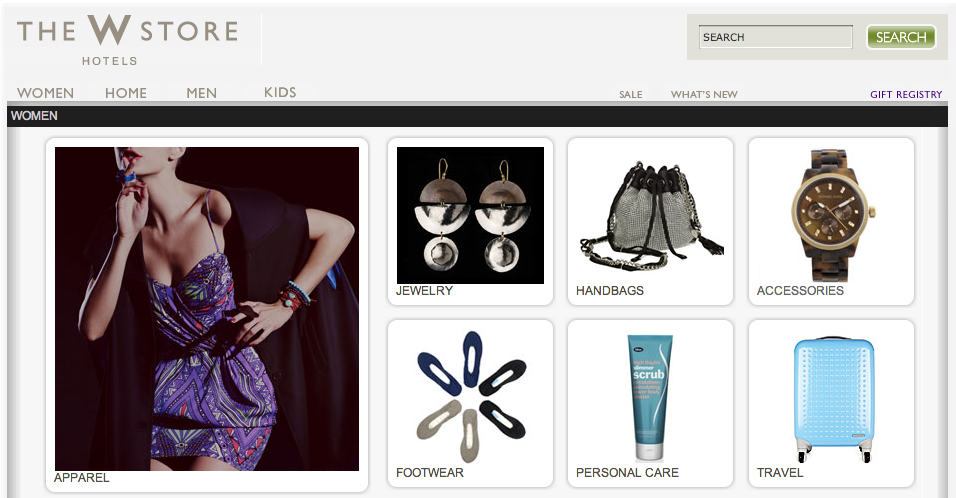
W Hotel’s W Store online
Online Stores
Want growth? Build online stores. Creating brand merchandise can strengthen customer loyalty and enlist fans to spread your name on the streets. Hotels, resorts and cruise lines are realising the tremendous potential in online merchandise, not to speak of the branding benefits.
One & Only led the way by pairing with hot designers to create limited edition, exclusive items for their resorts – Anya Hindmarch, Matthew Williamson and Christian Louboutin to name a few, all reinforcing the other’s stylish, chic image.
Hotels are broadening their merchandise mix with a greater variety of offerings that are indicative of the brands lifestyle and personality. We’ve come a long way from Westin’s Heavenly bedding, W’s music collection and more recently Ace Hotels’ urban clothing line.
Kimpton’s Style website offers an array of home goods (even dog beds!) to personalise consumer’s hotel experiences at home. However, they take it one step further by profiling a restaurant chef from one their properties, who provides a signature recipe, as well as selling a kitchen gadget to help in the execution of the recipe at hand.
Holland America easily has the industry’s most comprehensive online boutique offering a gamut of goodies, from art reproductions and cocktail mixers, to gourmet gift baskets and silk flowers. Royal Caribbean offers plenty of items branded with the cruise line’s blue and yellow logo, and Carnival, like most lines, has embraced the heavenly bed revolution by selling beds, bedding and bath linens.
To further investigate the industry year by year on Luxury Society, we invite your to explore the related materials as follows:
– 2013 Luxury Industry Predictions from the Experts
– 8 Trends That Defined The Luxury Industry in 2012
– Top 8 Luxury Travel & Marketing Trends for 2012









